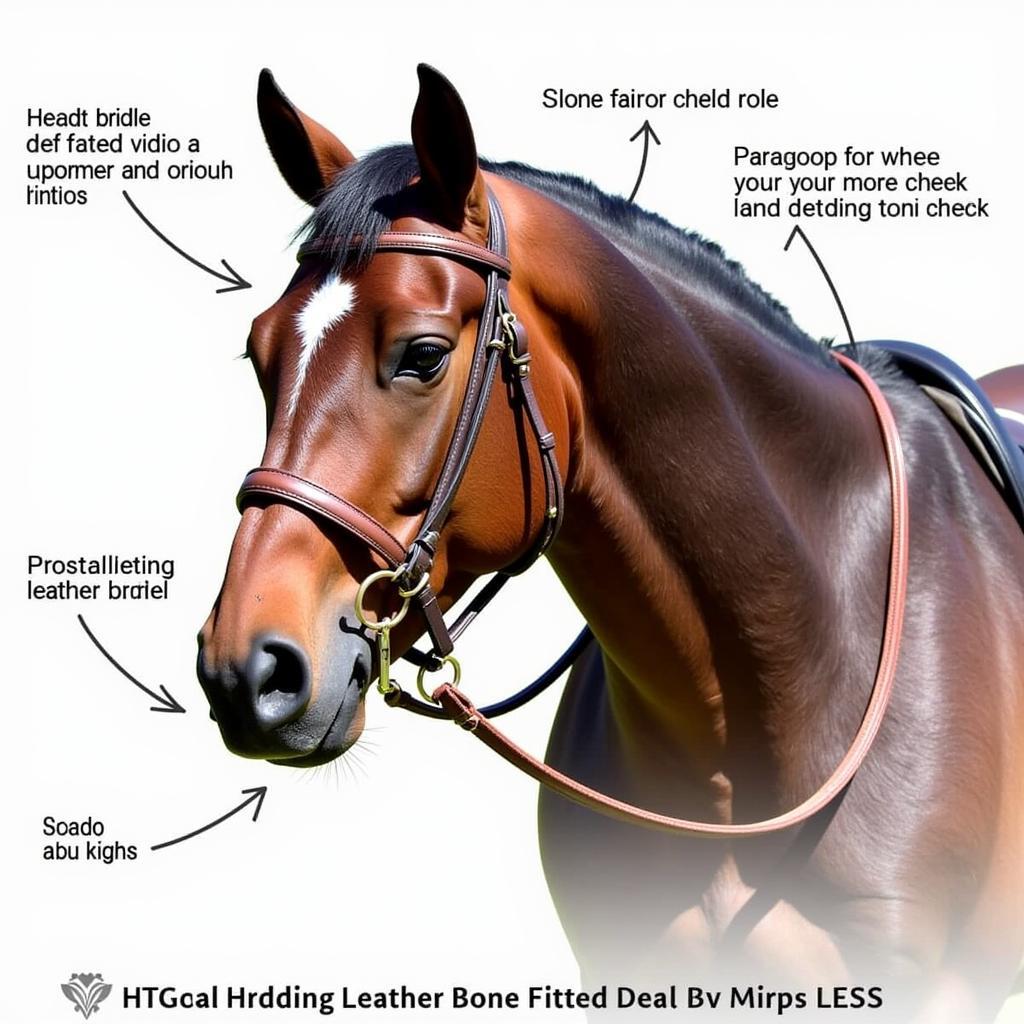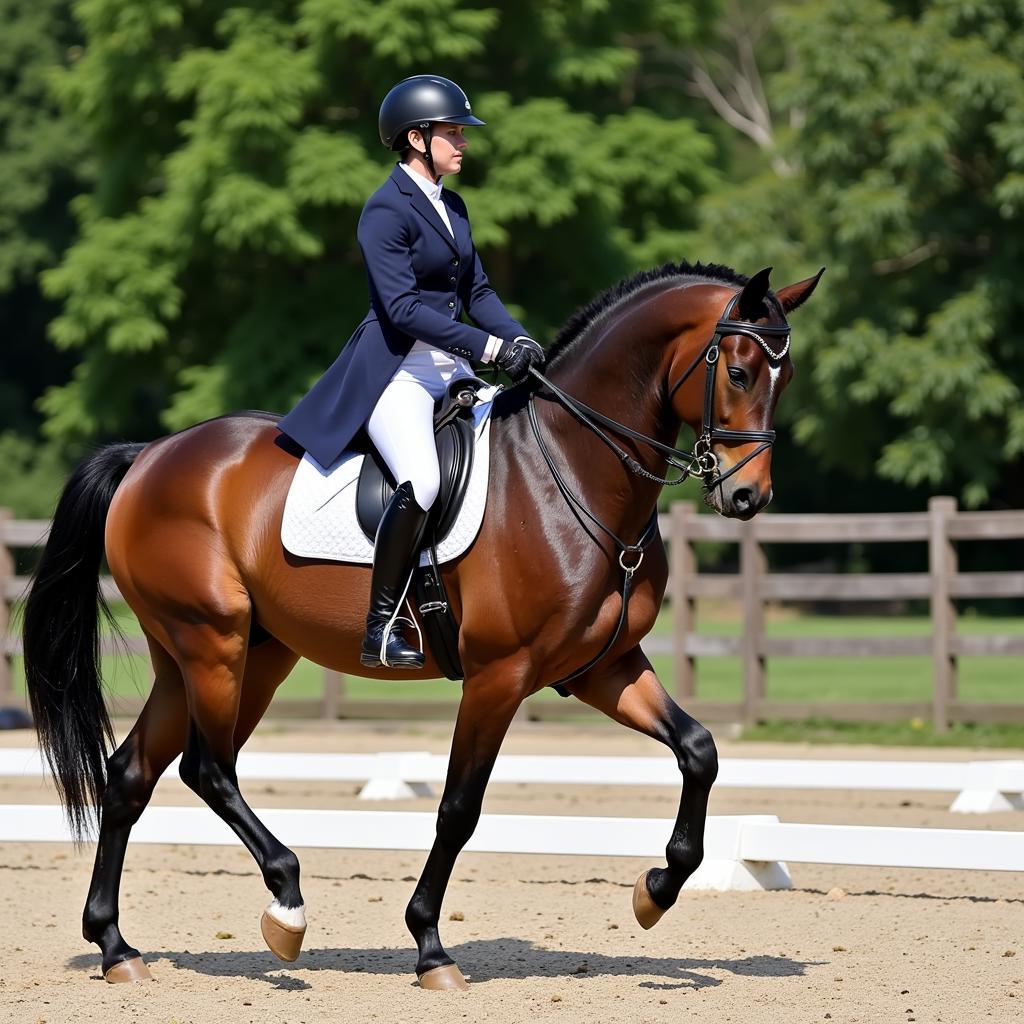A bridle is a fundamental piece of equipment for any horse, playing a crucial role in communication and control between rider and equine. More than just a headstall with reins attached, the right bridle is essential for your horse’s comfort, performance, and safety. With a plethora of styles and materials available, selecting the perfect bridle can feel overwhelming. This comprehensive guide delves into the intricacies of bridles, providing you with the knowledge to make an informed decision for your equine partner.
Understanding the Importance of a Properly Fitted Bridle
 Horse Bridle Fit
Horse Bridle Fit
A well-fitted bridle ensures your horse’s comfort and responsiveness to your aids. It distributes pressure evenly across the horse’s sensitive head, preventing discomfort, pain, and potential injury. Conversely, an ill-fitting bridle can lead to a range of issues, from rubbing and sores to headshaking, resistance, and even behavioral problems.
Types of Bridles: Exploring Different Styles and Their Uses
From the classic snaffle bridle to the more specialized double bridle, each type caters to specific disciplines and riding styles.
Snaffle Bridle: The Versatile Choice
The snaffle bridle, easily recognizable by its single bit and rein configuration, reigns supreme in various disciplines, from English riding disciplines like dressage and show jumping to Western riding and pleasure riding. Its popularity stems from its versatility and relatively mild action, making it suitable for horses of all levels.
Double Bridle: The Hallmark of Advanced Riding
 Double Bridle in Dressage
Double Bridle in Dressage
The double bridle, featuring two bits – a bradoon (snaffle bit) and a curb bit – and two sets of reins, represents the epitome of finesse and precision in advanced dressage. This sophisticated system allows for refined communication and subtle cues, enabling experienced riders to execute intricate movements.
Other Bridle Types: Catering to Specific Needs
Beyond the ubiquitous snaffle and double bridle, several specialized bridles cater to particular disciplines or address specific needs:
- Western Bridles: Often crafted with elaborate designs and decorative silver accents, Western bridles typically lack a noseband and feature a single rein attached to a curb bit.
- Hackamore: Ideal for horses with mouth sensitivities, the hackamore operates by applying pressure to the nose and chin, rather than the mouth, using a bosal or mechanical noseband.
- Bitless Bridles: Designed for horses that cannot tolerate any pressure in their mouths, bitless bridles use various configurations of straps to communicate cues through pressure points on the head.
Materials Matter: Choosing the Best for Your Horse
Bridle materials directly impact comfort, durability, and aesthetics.
Leather: The Classic Choice
Timeless and elegant, leather bridles offer unparalleled comfort and durability when properly cared for. Available in various qualities and price points, leather conforms to the horse’s head over time, providing a customized fit.
Synthetic Materials: Practical and Affordable
Synthetic bridles, crafted from materials like nylon or biothane, have gained popularity due to their affordability, ease of maintenance, and durability. They often come in various colors and styles, making them an attractive option for riders seeking a practical and budget-friendly alternative to leather.
Finding the Perfect Fit: Essential Considerations
A properly fitted bridle is paramount for your horse’s well-being.
Measuring Your Horse for a Bridle
Before purchasing a bridle, accurate measurements of your horse’s head are crucial. Use a soft tape measure and follow these general guidelines:
- Bit to Cheek: Measure from the corner of the mouth to the point where the cheekpiece will lay.
- Crownpiece: Measure around the horse’s head, passing behind the ears and over the poll (the highest point of the head).
- Throatlatch: Measure from the point of the cheek on one side, under the throat, to the corresponding point on the other side.
- Noseband: Measure around the horse’s nose, approximately two fingers’ width below the cheekbone.
Signs of a Poorly Fitted Bridle
Recognizing signs of a poorly fitted bridle is crucial for your horse’s comfort and well-being. Look for:
- Rub marks or sores on the horse’s skin.
- Headshaking, tossing, or resistance.
- Gaping or excessively tight straps.
- Uneven pressure points or bunching.
Bridle Care and Maintenance: Ensuring Longevity
Proper care and maintenance are vital for extending the lifespan of your bridle.
- Regular Cleaning: Clean your bridle after each ride to remove sweat, dirt, and grime.
- Conditioning Leather: Leather bridles benefit from regular conditioning to maintain their suppleness and prevent drying and cracking.
- Proper Storage: Store your bridle in a cool, dry place, away from direct sunlight and moisture.
Conclusion: Equipping Your Horse for Success
Choosing the right bridle for your horse is an essential aspect of responsible horsemanship. By understanding the different types, materials, and fitting considerations, you can ensure your equine partner enjoys optimal comfort, performance, and well-being. Remember, a well-fitted bridle is not just about aesthetics; it’s a cornerstone of clear communication and a harmonious partnership between horse and rider.
FAQs
What type of bridle is best for a beginner rider?
A snaffle bridle is generally recommended for beginner riders due to its simplicity and mild action.
How often should I clean my horse’s bridle?
Cleaning your horse’s bridle after each ride is ideal to prevent dirt and sweat from damaging the material.
Can I use a double bridle on a young horse?
Double bridles are typically reserved for experienced horses and riders in advanced disciplines like dressage.
What are the signs that my horse’s bridle needs replacing?
Signs of wear and tear, such as cracked leather, frayed stitching, or broken buckles, indicate a need for replacement.
How can I prevent my horse’s leather bridle from drying out?
Regular conditioning with a high-quality leather conditioner helps keep the leather supple and prevents drying and cracking.
For any further questions or assistance in selecting the perfect bridle for your equine companion, our expert team at Justus Horses USA is here to help. Contact us at Phone Number: 0772127271, Email: [email protected], or visit us at QGM2+WX2, Vị Trung, Vị Thuỷ, Hậu Giang, Vietnam. Our dedicated customer service team is available 24/7 to provide personalized guidance and support.